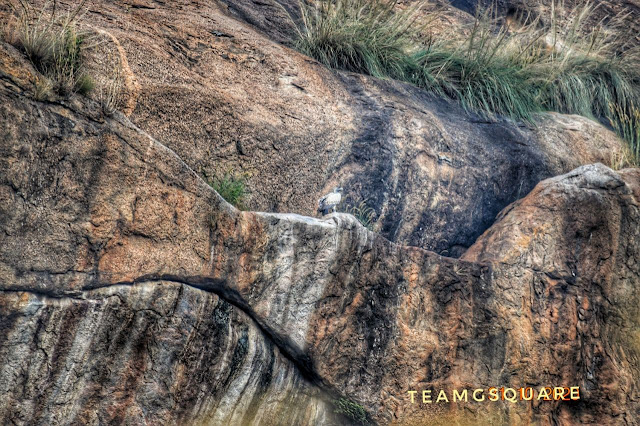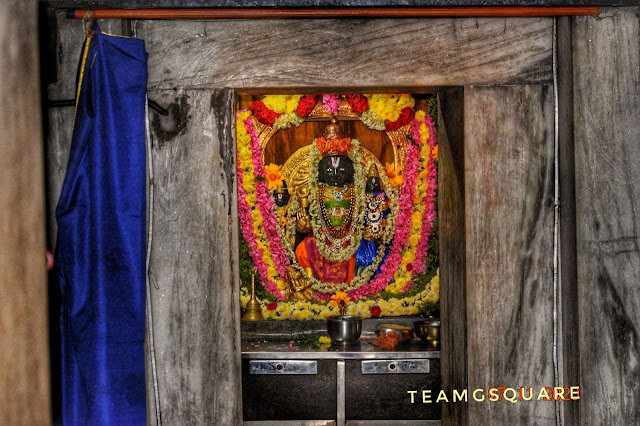151.Sri Siddeshwara temple, Siddanakolla
Taluk : Hungund, Bagalkot
Dynasty : Badami Chalukyas in the 7th Century, Kalyani Chalukyas in 11th Century
About : This temple complex has many ancient temples built around the valley, with a few cave temples around.
 |
| Sri Siddeshwara temple complex , Siddanakolla |
152.The Jaina Basadi, Pattadakal
Taluk : Badami, Bagalkot
Dynasty : Rashtrakutas in 9th Century
About : This temple consists of a garbhagriha with pradakshinapatha, an antarala, a sabhamandapa and mukhamandapa, with a Dravidian shikara. There is a beautifully carved stone ladder in this temple.
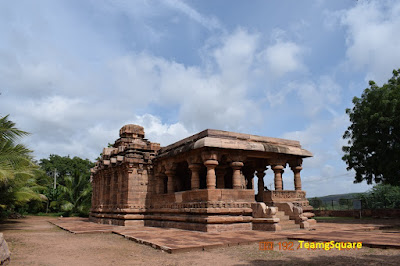 |
| Jaina Basadi, Pattadakal |
153. Sri Kalleshwara temple, Degulahalli
Taluk : Sampgaon, Belagavi
Dynasty : Kalyani Chalukyas in 12th Century
About :This temple has a garbhagriha, antarala, an open navaranga with 3 mukhamandapas. Although the Kadamba Nagara shikara remains damaged, the Shukanasi carries a beautiful carving of Lord Nataraja.
 |
| Sri Kalleshwara temple, Degulahalli |
154. Sri Kumaraswamy temple, Kudathini
Taluk : Ballari
Dynasty : Rashtrakutas in 10th Century
About : This temple has 3 garbhagrihas, a common antarala, and open sabhamandapa with a mukhamandapa. The shikara of this temple is missing. This temple is dedicated to Lord Subramanya or Kumaraswamy along with Lord Shiva. The main murti of Kumaraswamy is missing and has been replaced with a murti of Lord Ganesha.
 |
| Sri Kumaraswamy temple, Kudathini |
155. Sri Gangadhareshwara Swamy temple, Shivagange
Taluk : Nelamangala, Bengaluru Rural
Dynasty : Hoysalas in 13th century, Nada-Prabhus in 16th Century
About : This beautiful cave temple dedicated to Lord Shiva has been developed into a large temple with mantapas and prakara. There are 3 bronze images of Kempasomanna, Kempegowda and Ulli Chikanna right opposite to the main deity.
 |
| Sri Gangadhareshwara Swamy Temple, Shivagange |
156. Sri Channaraya Swamy temple, Nalluru
Taluk : Hoskote, Bengaluru Rural
Dynasty : Hoysalas in 13th Century, Vijayanagara in 14th Century
About : This ruined temple still has much of it outer walls intact, with niches having beautiful sculptures depicting Krishna Leele. The ceiling of the temple is completely damaged and there is no murti in the Garbhagriha.
 |
| Sri Channarayaswamy temple, Nalluru |
157. Sri Chokkanathaswamy temple, Domlur
Taluk : Bengaluru Urban
Dynasty : Hoysalas in 13th Century, Vijayanagara in 15th Century
About :This temple has a garbhagriha, antarala, navaranga and mukhamantapa and is dedicated to Lord Vishnu.
 |
| Sri Chokkanathaswamy temple, Domlur |
158. Sri Vasanthavallabha Swamy temple, Vasanthapura
Taluk : Bengaluru South, Bengaluru Urban
Dynasty : Cholas in 10th Century, Vijayanagara in 15th Century, Wodeyars in 17th Century
About : This temple is dedicated t
o Lord Srinivasa or Vallabha Swamy along with his consorts - Sridevi and Bhudevi. This temple has a garbhagriha, antarala, navaranga, sabhamandapa and mukhamandapa with a Dravidian shikara.
 |
| Sri Vasanthavallabha swamy temple, Vasanthapura |
159. Sri Bhalkeshwara Swamy temple, Bhalki
Taluk : Bhalki, Bidar
Dynasty : Rashtrakutas in 9th Century, Kalyani Chalukyas in 11th Century
About : This temple has undergone various modifications, hardly retaining its original form. The original portions of the temple lie scattered across the temple and its surroundings.
 |
| Sri Bhalkeshwara swamy, Bhalki |
160. Sri Eshwara Swamy temple, Morkhandi
Taluk : Basavakalyan, Bidar
Dynasty : Kalyani Chalukyas in 11th Century
About : This temple has a garbhagriha, antarala and sabhamandapa with a modern shikara. This temple is dedicated to Lord Shiva.
 |
| Sri Eshwara Temple, Morkhandi |
161. Sri Bhu Varaha Swamy temple, Yelandur
Taluk : Yelandur, Chamarajanagar
Dynasty :Vijayanagar in 16th Century
About : This temple has a garbhagriha, an antarala with pradakshinapatha, and a navaranga with mukhamandapa. This temple is dedicated to Bhu Varaha Swamy with Goddess Lakshmi.
 |
| Sri Bhu Varaha Swamy Temple, Yelandur |
162. Sri Eshwara Swamy temple, Ambale
Taluk : Yelandur, Chamarajanagar
Dynasty : Gangas in 8th Century ,Cholas in 10th Century
About : This temple consists of a square garbhagriha with an antarala, mahamandapa with a mukhamandapa with a beautiful brick and mortar Dravidian shikara.
 |
| Sri Eshwara Temple, Ambale |
163. Sri Bhoganandishwara Swamy temple, Nandi
Taluk : Chikkaballapura
Dynasty : Banas in 8th Century, Nolambas in 9th Century, Cholas in 10th Century and Various
About : This huge temple complex consists of many subsidiary shrines apart from the two main temples dedicated to Lord Shiva in the form of Bhoganandishwara and Arunchaleshwara.
 |
| Sri Bhoganandishwara swamy Temple, Nandi |
164. Twin Basadi, Angadi
Taluk : Mudigere, Chikmagalur
Dynasty : Hoysalas in 11th Century
About : The twin Basadi here is dedicated to the Jaina Tirthankaras Shantinatha and Neminatha. These temples follow similar pattern and have a garbhagriha, antarala and a navaranga with mukhamandapa.
 |
| Neminatha Basadi, Angadi |
165. Sri Rameshwara Swamy temple, Devarunda
Taluk : Mudigere, Chikmagalur
Dynasty : Hoysalas in 12th Century
About : This temple consists of a garbhagriha, an antarala, navaranga and a mukhamandapa with a Kadamba Nagara shikara enclosed in a prakara. This temple is dedicated to Lord Shiva.
 |
| Sri Rameshwara Swamy Temple, Devarunda |
166. Sri Siddeshwara Swamy temple, Brahmagiri
Taluk : Molakalmuru, Chitradurga
Dynasty : Hoysalas in 12th Century
About : This temple consists of a garbhagriha, an antarala, sabhamandapa and a mukhamandapa with a Kadamba Nagara shikara. This temple is dedicated to Lord Shiva.
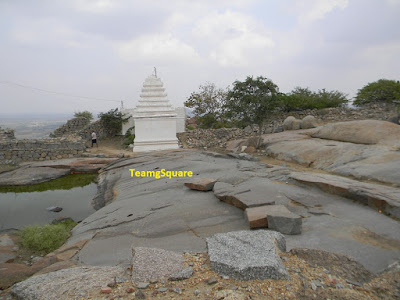 |
| Sri Siddeshwara Swamy Temple, Brahmagiri |
Taluk : Davanagere
Dynasty :Rashtrakutas in 8th Century, Chalukyas in 11th Century, Uchangi Pandyas in 12th Century
About : This temple consists of a garbhagriha, an antarala, navaranga and an open sabhamandapa with a unique Dravidian shikara. This temple is dedicated to Lord Shiva.
 |
| Sri Kalleshwara Swamy Temple, Bethuru |
168. Sri Kalleshwara Swamy temple, Kamadhenu
Taluk : Kalghatgi, Dharwad
Dynasty : Chalukyas in 11th Century, Hoysala in 12th Century
About : This temple consists of a garbhagriha, an antarala, sukhanasi, navaranga and 3 mukhamandapas with a renovated shikara in Kadamaba Nagara style. This temple is dedicated to Lord Shiva.
 |
| Sri Kalleshwara Swamy Temple,Kamadhenu |
169. Sri Brahma Jinalaya, Lakkundi
Taluk : Gadag
Dynasty : Chalukyas in 11th Century, Hoysala in 12th Century
About : This temple consists of a garbhagriha, an antarala, sukhanasi, navaranga and an open sabhamandapa with mukhamandapa. The shikara is of Vesara style and houses a beautiful murti of Neminatha. The Brahma murti installed in a much later period gives this temple the name of Sri Brahma Jinalaya.
 |
| Sri Brahma Jinalaya, Lakkundi |
170. Sri Trikuteshwara Swamy Temple, Gadag
Taluk : Gadag
Dynasty : Rashtrakutas in 10th Century, Chalukyas in 11th Century, Hoysalas in 12th Century
About : This temple consists of 3 main garbhagrihas, antarala, along with pradakshinapatha, navaranga a mukhamandapa, attached to Navaranga is an other garbhagriha dedicated to lord Surya Naryana with a mukhamandapa. In the same temple complex is another temple dedicated to Goddess Saraswathi.
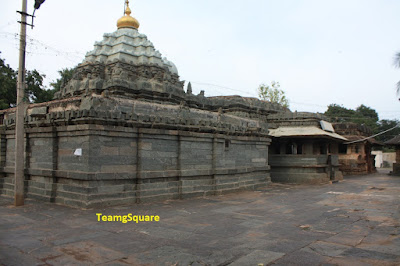 |
| Sri Trikuteshwara Swamy Temple, Gadag |
171. Sri Sharana Basaveshwara Swamy Temple, Kalburgi
Taluk : Kalburgi
Dynasty : Locals in 18th Century
About : This temple is dedicated to the very popular 18th century saint Sri Sharana Basaveshwara swamy who was renowned for his kayaka and dasoha. The temple consists of a garbhagriha which houses the samadhi of the swamy along with a sabhamandapa and pradakshinapatha.
 |
| Sri Sharana Basaveshwara swamy temple, Kalburgi |
Taluk : Channarayapatna, Hassan
Dynasty : Gangas in 10th Century, Hoysalas in 12th Century
About : This Basadi consists of a garbhagriha, an antarala, a sabhamandapa and mukhamandapa with Dravidian shikara.
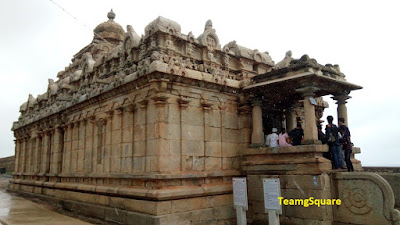 |
| Sri Chamundaraya Basadi, Shravana Belagola |
173. Sri Lakshmi Narasimha Swamy temple, Javagallu
Taluk : Arsikere, Hassan
Dynasty : Hoysalas in 13th Century
About : This temple consists of 3 garbhagrihas, an antarala (to the main garbhagriha), a common navaranga and a mukhamandapa with 2 ankanas with Dravidian shikara. This temple is dedicated to Lord Vishnu as Shridhara along with Lords Venugopala and Lakshmi Narasimha.
 |
| Sri Lakshmi Narasimha Temple, Javagallu |
174. Sri Kamala Narayanaswamy temple, Heragu
Taluk : Hassan
Dynasty : Hoysalas in 13th Century
About : This temple consists of a garbhagriha, antarala, navaranga and a mukhamandapa with Kadamba Nagara shikara. This temple is dedicated to Lord Vishnu in from of Kamala Narayana.
 |
| Sri Kamala Narayanaswamy temple, Heragu |
175. Sri Harihareshwara Swamy temple, Hariharapura
Taluk : Arsikere, Hassan
Dynasty : Hoysalas in 13th Century
About : This temple consists of 3 garbhagrihas with an antarala, sabhamandapa and a mukhamandapa. All three garbhagrihas are empty which once housed murtis of Lords Harihara, Ananthapadmanabha and Goddess Saraswathi. Currently these murtis are in Denmark.
 |
| Sri Harihareshwara Swamy Temple, Hariharapura |
Taluk : Haveri
Dynasty : Kalyani Chalukyas in 11th Century, Hoysalas in 13th Century
About : This temple consists of a Garbhagriha, an antarala and a navaranga with mukhamandapa. This temple has been renovated with remnants of the old structure and is dedicated to Lord Shiva.
 |
| Sri Basaveshwara Temple, Devagiri |
177. Sri Veerabhadreshwara Swamy temple, Hangal
Taluk : Hangal, Haveri
Dynasty : Hangal Kadambas in 12th Century
About : This temple consists of a garbhagriha, an antarala and a navaranga with 3 mukhamandapas. This temple has been renovated and is dedicated to Lord Veerabhadra Swamy.
 |
| Sri Veerabhadreshwara Swamy Temple, Hangal |
Taluk : Madkeri, Kodagu
Dynasty : Rajas of Kodagu in 18th Century
About : A large temple built in Kodagu Raja architectural style and is a very unique temple. The temple has a big dome with four minarets. This temple is dedicated to Lord Shiva and has a big Kalyani in the front.
Sri Omkareshwara Swamy Temple, Kodagu
179. Sri Kolaramma temple, Kolar
Taluk : Kolar
Dynasty : Gangas in 8th Century
About : This temple has a garbhagriha, antarala and sabhamandapa enclosed in a prakara with a Dravidian shikara. This temple is dedicated to Devi Mahishasuramardhini or Kolaramma, along with the Saptamatrikas.
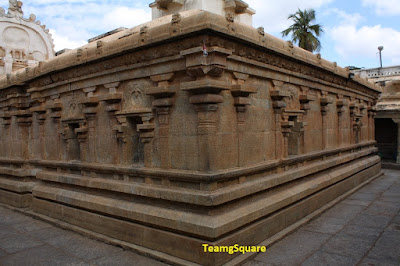 |
| Sri Kolaramma Temple, Kolar |
180. Sri Someshwara Swamy temple, Arabi Kothanur
Taluk : Kolar
Dynasty : Hoysalas in 13th Century
About : This temple consists of a garbhagriha, antarala, sukhanasi, navaranga with mukhamandapa and a renovated shikara. This temple is dedicated to Lord Shiva.
 |
| Sri Someshwara Swamy Temple, Arabi Kothanur |
181. Sri Markandeshwara Swamy temple, Vokkaleri
Taluk : Kolar
Dynasty : Vijayanagara in 16th Century
About : This temple complex consists of many small temples, the main temple is dedicated to Lprd Shiva in the form Markandeshwara. This temple is atop a small hill.
 |
| Sri Markandeshwara Swamy Temple, Vokkaleri |
182. Sri Brahmeshwara Swamy temple, Kikkeri
Taluk : K R Pete, Mandya
Dynasty : Hoysalas in 12th Century
About : This temple consists of a garbhagriha, an antarala, a navaranga and a Nandi mandapa with a Dravidian styled shikara. This temple is dedicated to Lord Shiva. The pillars of the navaranga are surmounted by beautiful Madanika sculptures.
 |
| Sri Brahmeshwara Swamy Temple, Kikkeri |
Taluk : K R Pete, Mandya
Dynasty : Hoysalas in 12th Century
About : This
temple consists of a garbhagriha, an antarala, navaranga and
mukhamandapa with a Dravidian shikara. This temple is dedicated to Lord
Shiva. Although the temple lies in a ruined state, it is a live temple.
 |
| Sri Hoysaleshwara Swamy temple, Tenginghatta |
Taluk : K R Pete, Mandya
Dynasty : Hoysalas in 12th Century
About : This
temple consists of a garbhagriha, an antarala, navaranga and
mukhamandapa with a Dravidian shikara. This temple is dedicated to Lord
Shiva. The temple compound has been converted in to a museum.
 |
| Sri Huneshwara Swamy Temple, Agrahara Bachahalli |
185. Sri Kashi Visveshwara Swamy temple, Hosabudanur
Taluk : Mandya
Dynasty : Hoysalas in 12th Century
About : This temple consists of a garbhagriha, an antarala, navaranga and mukhamandapa with a Vesara shikara. This temple is dedicated to Lord Shiva.
 |
| Sri Kashi Visveshwara Swamy Temple, Hosabudanur |
186. Sri Bhaktavatsala Swamy temple, Belagola
Taluk : Srirangapatna, Mandya
Dynasty : Hoysalas in 12th Century
About : This is a unique temple having a circular garbhagriha with the rest of the temple missing. The temple is dedicated to Lord Ganesha, but murti is missing and has undergone renovation recently. Nearby is another temple dedicated to Lord Janaradhana.
 |
| Sri Bhaktavatsala Swamy temple, Belagola |
187. Sri Arkeshwara Swamy temple, Hale Yedathore
Taluk : K R Nagar, Maisooru
Dynasty : Gangas in 9th Century, Wodeyars in 17th Century
About : This
temple complex is enclosed in a prakara and has many small temples. The
main temple is dedicated to Lord Shiva in the form of Arkeshwara
and consists of garbhagriha, antarala, sabhamandapa and mukhamandapa
with a Dravidian shikara.
 |
| Sri Arkeshwara Swamy Temple, Hale Yedathore |
188.Sri Kodanda Ramadevara Swamy temple, Chunchanakatte
Taluk : K R Nagar, Maisooru
Dynasty : Wodeyars in 17th Century
About : This temple consists of a garbhagriha, antarala, sabhamandapa and mukhamandapa. This temple is dedicated to Lord Rama.
 |
| Sri Kodanda Rama Swamy Temple, Chunchanakatte |
189. Sri Arunchaleshwara Swamy temple, Harohalli
Taluk : Kanakapura, Ramanagara
Dynasty : Gangas in 8th Century, Cholas in 10th Century
About : This temple complex is enclosed in a prakara and has many small temples. The main temple is dedicated to Lord Shiva in the form of Arunchaleshwara and consists of garbhagriha, antarala, sabhamandapa and 2 mukhamandapas with a renovated shikara.
 |
| Sri Arunchaleshwara Swamy Temple, Harohalli |
190. Sri Rameshwara swamy temple, Kuppagadde
Taluk : Soraba, Shivamogga
Dynasty : Hoysalas in 12th Century
About : This temple consists of a garbhagriha, antarala, ardhamandapa, open sabhamandapa with Kadamba Nagari shikara. This temple is dedicated to Lord Shiva.
 |
| Sri Rameshwara Swamy Temple, Kuppagade |
191. Sri Pranaveshwara Swamy temple, Talagunda
Taluk : Shikaripura,Shivamogga
Dynasty : Kadambas in 4th Century
About : This is one of the earliest surviving temples built in the region of Karnataka. It is a simple structured temple housing a huge Shiva linga.
 |
| Sri Pranaveshwara temple, Talagunda |
192. Sri Aghoreshwara Swamy temple, Ikkeri
Taluk : Sagara, Shivamogga
Dynasty : Keladi Nayakas in 15th Century
About : This temple complex consists of two temples, with the main temple dedicated to Lord Shiva in the form of Aghoreshwara. The main temple consists of a garbhagriha, antarala and navaranga with a Dravidian shikara enclosed in a prakara.
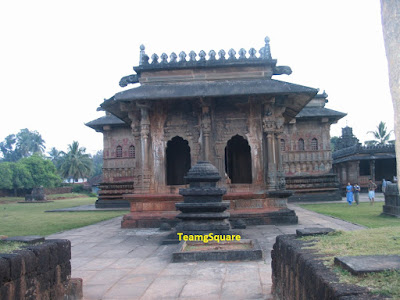 |
| Sri Aghoreshwara Swamy temple, Ikkeri |
193. Sri Venugopala Swamy temple, Nonavinakere
Taluk : Tiptur, Tumkooru
Dynasty : Hoysalas in 12th Century
About : This temple consists of 3 garbhagrihas, antarala, navaranga and mukhamandapa with a Dravidian Shikara. This temple houses beautiful murtis of Lords Venugopala, Keshava and Yoga Narasimha.
 |
| Sri Venugopala Swamy Temple, Nonavinakere |
194. Sri Vidyashankara Swamy temple, Durgadahalli
Taluk : Tumkooru
Dynasty : Hoysalas in 12th Century
About : This temple consists of a garbhagriha, antarala, sabhamandapa and a mukhamandapa with a Kadamba Nagara shikara. This temple is dedicated to Lord Shiva.
 |
| Sri Vidyashankara Swamy Temple, Durgadahalli |
195. Sri Ramadevara Swamy temple, Nidugal
Taluk : Pavagada,Tumkooru
Dynasty : Vijayanagara in 15th Century
About : This beautiful cave temple is situated at the base of the Nidugal hill. There is a unique carving of Lord Rama along with Sita Devi and his 3 brothers. There are carvings of Lord Anjaneya and Goddess Mahishasura Mardhini.
 |
| Sri Ramadevara Swamy Temple, Nidugal |
196. Sri Gangadhareshwara Swamy temple, Turuvekere
Taluk : Turuvekere,Tumkooru
Dynasty : Hoysalas in 13th Century, Vijayanagara in 16th Century
About :This temple consists of a garbhagriha, an antarala, sabhamandapa and mukhamandapa. This temple is dedicated to Lord Shiva and a unique feature of the Shiva Linga here is the presence of Jata (hair) on the Linga depicting Lord Gangadhareshwara. There is a beautiful stone bell belonging to the Vijayanagara period.
 |
| Sri Gangadhareshwara Swamy Temple, Turuvekere |
197. Sri Kattale Basadi, Barkur
Taluk : Brahmavara, Udupi
Dynasty : Alupas in 11th Century
About :This temple consists of a garbhagriha, an antarala and mukhamandapa enclosed in a prakara with an adjoining Lord Shiva temple in the complex.
 |
| Kattale Basadi, Barkur |
198. Sri Khetappayya Narayana Swamy temple, Mudbhatkal
Taluk : Bhatkal, Uttara Kannada
Dynasty : Keladi Nayakas in 16th Century
About : This temple consists of a garbhagriha with pradakshinapatha and navaranga with gabled roof and lattice stone windows enclosed in a prakara. This temple is dedicated to Lord Narayana.
 |
| Sri Khetappayya Narayana Swamy Temple, Mudbhatkal |
199. Sri Hanumantha Swamy temple, Yadgir
Taluk : Yadgir
Dynasty : Kalyani Chalukyas in 12th Century
About : This temple consists of a garbhagriha, antarala and navaranga. This temple has been converted into Hanumantha Swamy temple and has undergone various modifications.
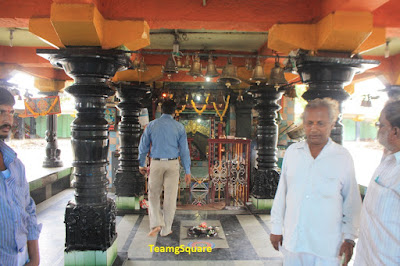 |
| Sri Hanumantha Swamy temple, Yadgir |
200. Sri Venugopalaswamy temple, Shorapur
Taluk : Shorapur, Yadgir
Dynasty : Surpur Nayakas in 17th Century
About : This temple consists of a garbhagriha, antarala and an open sabhamandapa. This temple is dedicated to Sri Venugopalaswamy.
 |
| Sri Venugopala Swamy Temple, Shorapur |
This is the 4th part of Temples of Karnataka and in total covers all the districts of Karnataka except Raichur. We will continue to update this list as and when possible. This list is just a representation of the great work done by various dynasties that ruled Karnataka. Also with this, we have completed 10 years of blogging and would like to express our heart felt thank you to each one of you who have helped, supported and encouraged us in our journey. Hope this journey continues and we do justice to our blog and travel!
Kind Note: Please avoid traveling now and take all the necessary precautionary measures for safety and hygiene. It is a temporary phase and we all, together, will overcome this phase of pandemic outbreak. Take care and stay safe.
References:
1. Temples of Karnataka-Book edited by Dr. KM Suresh
2. Various District Gazetteers
Related Posts:
1. Top 100 lesser known temples of Karnataka
2. Top 50 must visit lesser known temples of Karnataka
3. Forts of Karnataka


